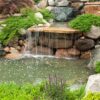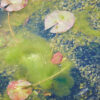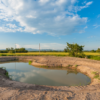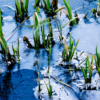How To Dispose Of Pond Sludge?
Although pond sludge is a nasty and smelly material, it is not that bad after all. Once you thoroughly clean your pond, and find the bottom surface of your pond caked in pond sludge, it is recommended not to throw it away because it has several uses elsewhere, such as being wonderful to your garden.
Despite your best efforts of keeping your pond clean and tidy, pond sludge is a reality that is inevitable for you to face. Hence, there is no need to resent it, or look at it with sheer disgust because it is a product of a natural and organic process.
In this article, you will learn everything there is to know about pond sludge. Specifically, we will be highlighting various methods of pond sludge disposal that are rarely used these days, but are highly effective and proven to work.
But, first, there is some light to be shed on the extreme form of dark algae that sits at the bottom of all ponds and aquariums, all over the world.
A Brief Overview of Pond Sludge
Pond sludge is a culmination of organic matter pertaining to various types. Pond sludge consists of several materials, including:
- Decomposing leaves and plants
- Algae
- Fecal matter
- Dirt, debris, and gravel
- And, decaying carcasses of fish
Due to an enormous amount of organic matter, filled to the brim, pond sludge is loaded with nutrients and other vital resources to sustain and invigorate life. It is a testament to a pond’s natural cycles over its lifetime, hence pond sludge is not that bad afterall since it is a sign of a healthy and thriving pond.
Pond sludge is primarily found at the bottom of the pond as it sinks down and settles, forming a thick and sludgy layer.
Pond sludge will not consist of the same organic and inorganic elements in every location. In the end, its constituents and intensity can come down to several climatic and biological factors.
The awful stench, a characteristic of pond sludge, is produced when anaerobic bacteria inside the sludge decompose its organic matter. This reaction releases hydrogen sulfide, a toxic gas which produces a stench. In large amounts, this can prove to be immensely troublesome for a pond, which is why having unchecked levels of pond sludge is a detrimental and ignorant idea.
Pond Sludge
How is Pond Sludge Good for a Pond?
The million dollar question in the pond community; often, pond owners, especially new entrants into the pond world, are intrigued to find out about the following benefits of pond sludge:
- Small amounts of pond sludge can be exceptionally advantageous for ponds, especially wildlife ponds because pond sludge is home to innumerable species of bacteria and larvae that harvest their colonies and inhabit this organic world.
- Pond sludge is also a vital food source for algae and fully submerged aquatic plants.
- It can also be used as an effective fertilizer solution for your garden.
Keeping the benefits in mind, the disadvantages of pond sludge accumulation can be devastating for the health of your pond and its wildlife, hence, it is always a good idea to remove a large proportion of pond sludge on a periodic basis.
Why is Pond Sludge Bad?
Firstly, the build-up of pond sludge gives rise to the amount of hydrogen sulfide inside your pond. This is a fatal mistake to make as high levels of hydrogen sulfide create an extremely toxic environment inside ponds. Moreover, the harmful gas also suffocates fish and other wildlife. Plus, the awful stench will draw all sorts of biological species, including us humans, away from the pond.
In the absence of sufficient amounts of beneficial aerobic bacteria, pond sludge is essentially a breeding ground for algae blooms as there is no bacteria to break down rapid algae growth.
How to Dispose Of Pond Sludge?
Identifying that your pond has sludge at the bottom is the easy part; removing it is a task on its own. But, luckily for you, we will present to you a few tried and tested solutions to deal with your pond sludge like a professional pond owner.
The Brute Physical Approach
You can always count on the safest and easiest way that comes to mind; using your bare hands to remove the sludge. Pond owners do this once after a monthly durational period. Although it requires plenty of brute force, it is easily done by placing all the fish in a separate tank.
Now, the pond water is drained or its surface level is reduced so that the cleaner can easily jump inside and clean the gunk on the bottom in a shallower pond. Another convenient way of incorporating the physical method to clean your pond sludge is to use a pond vacuum.
Pond vacuums are well-equipped with the necessary suction power to annihilate most of the treacherous pond sludge found at the bottom of your pond. They will easily deal with even the toughest and nastiest of pond sludge. There are two types of pond vacuums: hand-pump and electronic vacuums. Hand-pump vacuums are ideal for relatively shallow and small ponds because the cleaner can single handedly use them. Electronic vacuums are suitable for large and deep ponds as they pump out dirty water and other sediments.
However, using the physical approach has a few flaws. It can be a raw and indirect approach as almost everything is scooped up along with the sludge. This includes helpful aerobic bacteria that are vital for decomposing purposes inside the pond; aerobic bacteria maintain and dictate the indispensable natural nitrogen cycle inside a pond.
If you use the physical approach, you will end up missing out on dealing with a significant chunk of hydrogen sulfide, which can prove to be damaging for your pond’s health.
Removal of Pond Sludge
Sludge Digesting Bacteria; The Smart Way To Go
Pond owners who experience moderate sludge build-up will be most suited to employing additional anaerobic bacteria into their ponds. Various anaerobic bacteria are known for their ability to naturally decompose layers of sludge, organic matter. Also, added anaerobic bacteria act as catalysts to speed up the process of natural decomposition inside a pond.
These efficient bacteria also reduce the risk of oxygen reduction inside a pond, an unfortunate condition that can prove to be fatal for even a healthy pond.
Today, you can find several helpful bacteria products on the market that are specifically designed to combat excessive sludge levels in ponds without being toxic and irritating to other wildlife species, such as fish and aquatic plants. They are designed to have as few side-effects as possible.
Using a Sludge Shovel
There are several sludge shovels on the market that are especially designed to scoop up sludge and debris from the bottom of a shallow and small pond, being quite effective in their operation. This is an easier and more convenient way of removing pond sludge as compared to removing sludge manually by hand.
However, sludge shovels are only limited to small ponds. Also, shoveling pond sludge can be dangerous for aquatic life, especially your pond’s aquatic plants because you can mistakenly damage the roots of your pond’s plants.
After you use a pond shovel for removing sludge, you will be removing some friendly bacteria as well. To counter this problem, numerous pond owners add bacteria products to their pond to equalize the natural levels of bacteria.
Pond Dredging for Large-scale Removal of Pond Sludge
Using a pond dredge for removing pond sludge is an extreme case. Usually, in large ponds, pond owners use pond dredging as the last resort, after sludge levels have dangerously risen to the point where the risk of restarting the entire ecosystem of a pond is lower than the risk of sludge.
Pond dredging removes pond gunk from the grassroot level, completely annihilating everything in its place. Unsurprisingly, this will tarnish the vast majority of wildlife inside your pond, completely destroying the pond’s natural ecosystem in the process. Thus, pond dredging is not to be taken lightly, and should only be used in the most extreme cases.
The Last Step: Composting
Now that you have understood the ways of ridding pond muck from your pond, and have done so, what will you do with all the pond muck left behind from the cleanup?
If you are considering completely disposing of it without a second thought, think again; pond sludge can be gold for your garden and its soil.
Pond sludge can be a pivotal part of the compost that you add to your garden and vegetation.
Here a few simple separate pointers to make compost using pond sludge, by yourself:
- After you have bought your compost or made it by yourself in a bin, add pond sludge to the compost inside the bin. Finally, add a layer of soil on top of it to mix and naturalize the pond sludge with your compost. The bacterial properties of the soil will help further decompose the sludge.
- If you are making your own compost pile, you will have to choose materials that are rich in carbon. Certain examples include: fallen leaves, organic waste from households, straw, and shredded paper. Once you have made a 6-inch layer with these materials, mix in your pond sludge into the compost pile alongside other materials rich in nitrogen, such as fresh grass and vegetable leftovers, creating a 3-inch layer. Finally, on top of this pile, add another 2-inch layer of soil.
- Your compost will be ready to use when it will turn dark and have an earthy aroma.
Composting
Prevention is Better than Cure
The famous term can be aptly used for pond sludge as well. If pond owners proactively incorporate preventive measures into their pond maintenance regime, they can easily negate the problem of excess sludge build-up, overall.
Following are a few suggestions to prevent the unnecessary growth of rapid pond sludge, which has a trickle-down effect as it causes several other problems.
Cover Your Pond
If you allow various organic materials to enter your pond in an easy manner, you will soon experience rising sludge levels at the bottom. Twigs, falling leaves, fecal waste, and debris, are just a few materials that will inevitably enter your pond if care is not taken. Importantly, you should also check for fertilizer runoff and decaying matter at the banks of your pond because they vigorously cause sludge creation.
After entering the pond, they will soon sink below and decompose, forming severe sedimentation below. Ultimately, a pith will form and soon, it will turn into pond sludge.
This can be done through covering your pond with a net. Or, manually removing material from your pond using a pole net. Vacuuming is another option worth considering.
Healthy Amounts of Oxygen Go a Long Way
The oxygen level of a pond is not only necessary for the absolute survival of its wildlife, it is also critically important for an efficient decomposition process to take place. If oxygen levels are troublesome, decomposition will slow down, and as a result, materials and decaying matter will settle down at the bottom of the pond, eventually turning into pond sludge.
The oxygen levels in your pond can be easily maintained by ensuring the plantation of several aquatic plants inside, and on the banks of your pond. Aeration and filtration systems also ensure that your pond receives an ample supply of oxygen from the surface as the clean water will move continuously.
Concluding Remarks
Similar to everything, pond sludge has its share of positives and negatives. Pond sludge, in a marginal amount, is a sign of a healthy pond with natural and organic activity. However, if kept unchecked, the sludge can turn into a serious nightmare for a pond due to the problem of toxic hydrogen sulfide and lack of oxygenation. It is always better to take preventive measures to curtail the daunting consequences of substantial sludge growth in a pond.










